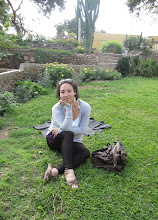


Coffee in Peru is otherwise disappointing. Instant is the caffeine of choice, and it's getting harder and harder to swallow. But there is something that helps: Manjar. It's the light of my little Peruian world and I can't get enough of it. It's kind of like dulce de leche in spreadable caramelly goodness. Put a little of that on your pan and you can drink all the instant coffee Peru throws at ya.
On to the Sacred Valley...
There are too few words to describe how infinitely small you feel when you're walking inside a town in valley of towering mountains. I traveled to Pisaq today, as well as a few other towns. We took the long route there as the bridge in Pisaq is still out after the raging Urubamba River severely damaged it a few weeks ago. It took about 2 hours to get there while the normal route is about 30 minutes. Why anyone would want to take the regular route is beyond me. "Spectacular" doesn't even begin to describe the views. The roads hug the mountains and the buses wind up, down and around each valley so that one moment you feel like you're on top of the world and the next minute you're just a speck of sand.
Waterfalls popped out of the mountains like faucets and the different colors of green are astounding. I wish I had pictures to share but I spent most of the drive with my mouth hanging open in awe.
We spent the day in Pisaq, shopping at the stalls and eating empanadas. There's a famous empanada place in Pisaq (with a little guinea pig house so you can pick your own live one and have it cooked right in front of you) and we lounged there for almost 2 hours, drinking cafe con leche and watching the empanadas come out of the massive wood-burning oven in the wall.
I bought a piece of amethyst and a pair of silver earrings at one of the market stalls. The energy coming from these stones is stronger than I've felt anywhere before. I could barely touch done of them. The bus ride back (from the other side of the damaged but still walkable bridge) took about 30 minutes. We hung out in the center of Cusco at a hookah bar for a few hours before parting ways. The rain held off until I got in my taxi and headed home.
A note about the mudslides Cusco and the surrounding areas that suffered last month: Cusco is slowly pulling itself up by the bootstraps. Blue tarps abound over houses on the hills around the center of town and some of the towns in the Sacred Valley are also dealing with their share of cleanup and repair. The work will get done, as the country's livelihood depends on tourism, and I wouldn't hesitate for a minute to recommend coming here even now.
I'll be checking on my Machu Picchu plans with my travel company some time this week and will let you know the status. Everyone around here has a different story about whether the site is open, if there are other routes to take besides the Inca Trail, etc. And here's what I currently know: there are definitely other routes. The trail is closed every February for maintenance, so I wasn't even considering it when I planned the trip. As far as I know, our route (the Lares trek) is still wide open. The problem is getting back down from MP, as some of the train tracks are still damaged. There are other ways down though, primarily buses and cars. It will be a longer ride, but who cares when you're traveling through this amazing country???
I'll report back when I know more later this week.


No comments:
Post a Comment